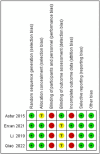Double-bundle versus single-bundle medial patellofemoral ligament reconstruction for recurrent patellar dislocation: A meta-analysis
- PMID: 39697989
- PMCID: PMC11653220
- DOI: 10.1002/jeo2.70112
Double-bundle versus single-bundle medial patellofemoral ligament reconstruction for recurrent patellar dislocation: A meta-analysis
Abstract
Purpose: To compare the clinical efficacy of single-bundle versus double-bundle reconstruction of the medial patellofemoral ligament (MPFL) for recurrent patellar dislocation (RPD) regarding knee function scores, postoperative complications, and imaging assessments.
Methods: A computerized search of PubMed, Cochrane Library, Embase, China Biomedical Literature Database (CBM), China National Knowledge Network (CNKI), and VIP Database was performed for single-bundle versus double-bundle reconstruction of the medial patellofemoral ligament for treatment of RPD. Randomized controlled trials (RCTs) were evaluated for quality using the risk-of-bias evaluation tool recommended by the Cochrane Collaboration Network, and Cohort studies (CSs) were assessed using the Newcastle-Ottawa Scale (NOS) scale. Meta-analysis was performed using RevMan 5.3 software and STATA 16.0.
Results: Thirteen studies were included, four randomized controlled studies, and nine cohort studies. The level of evidence for the four randomized controlled studies was Ⅰ, and the nine cohort studies were Ⅲ. A total of 862 (891 knees) patients were included, of which 448 (465 knees) underwent double-bundle MPFL reconstruction and 414 (426 knees) underwent single-bundle MPFL reconstruction. Kujala score (MD = 2.06, 95% confidence interval [CI] [0.11, 4.01], p < 0.05), Tegner score (MD = 0.39, 95% CI [0.11, 0.68], p < 0.05), International Knee Documentation Committee (IKDC) score (MD = 4.88, 95% CI [1.46, 8.31], p < 0.05), and postoperative recurrence instability (odds ratio [OR] = 0.12, 95% CI [0.04, 0.44], p < 0.05) were better in the double-bundle group than in the single-bundle group. Lysholm score (MD = 0.86, 95% CI [-0.76, 2.48], p = n.s), patellar tilt angle (MD = -0.22, 95% CI [-0.54, 0.10], p = n.s), patellar lateral shift rate (MD = -0.16, 95% CI [-0.41, 0.09], p = n.s), congruence angle (MD = 0.06, 95% CI [-0.41, 0.52], p = n.s), postoperative knee pain (OR = 0.39, 95% CI [0.14, 1.11], p = n.s), and additional postoperative surgical treatment (OR = 0.20, 95% CI [0.01-6.25], p = n.s) had no statistically significant differences.
Conclusions: Double-bundle reconstruction of the medial patellofemoral ligament for RPD was superior to single-bundle reconstruction in both knee function scores and postoperative recurrent patellar instability, and double-bundle reconstruction of the medial patellofemoral ligament for RPD had better clinical outcomes.
Level of evidence: Level Ⅲ, Ⅰ and Ⅲ studies.
Keywords: double‐bundle; medial patellofemoral reconstruction; meta‐analysis; recurrent patellar dislocation; single‐bundle.
© 2024 The Author(s). Journal of Experimental Orthopaedics published by John Wiley & Sons Ltd on behalf of European Society of Sports Traumatology, Knee Surgery and Arthroscopy.
Conflict of interest statement
The authors declare no conflicts of interest.
Figures
















Similar articles
-
Double-Limb Graft Versus Single-Limb Graft Medial Patellofemoral Ligament Reconstruction for Recurrent Patellar Dislocation: A Meta-analysis of Randomized Controlled Trials and Cohort Studies.Am J Sports Med. 2023 Oct;51(12):3313-3324. doi: 10.1177/03635465221130448. Epub 2022 Nov 29. Am J Sports Med. 2023. PMID: 36444888
-
Reconstruction of the medial patellofemoral ligament through a double bundle of a single patellar tract and quadriceps tendons combined with medial displacement of lateral hemi-tibial tuberosity for treating low-grade recurrent patella dislocation.Int Orthop. 2024 Apr;48(4):913-922. doi: 10.1007/s00264-024-06105-8. Epub 2024 Feb 12. Int Orthop. 2024. PMID: 38342822
-
Medial Patellofemoral Complex Reconstruction (Combined Reconstruction of Medial Patellofemoral Ligament and Medial Quadriceps Tendon-Femoral Ligament) With Semitendinosus Autograft Resulted in Similar Clinical and Radiographic Outcomes to Medial Patellofemoral Ligament Reconstruction in Treating Recurrent Patellar Dislocation.Arthroscopy. 2024 Apr;40(4):1264-1276.e1. doi: 10.1016/j.arthro.2023.08.079. Epub 2023 Sep 15. Arthroscopy. 2024. PMID: 37716628
-
Reconstruction of the medical patellofemoral ligament through a double-bundle and suspension fixation of the adductor muscle tendon combined with semi-patellar ligament displacement for treating recurrent patellar dislocation in adolescents with unclosed epiphysis: a retrospective study.Eur J Orthop Surg Traumatol. 2025 Mar 24;35(1):130. doi: 10.1007/s00590-025-04259-8. Eur J Orthop Surg Traumatol. 2025. PMID: 40126666 Review.
-
Single- and double-bundle medial patellofemoral ligament reconstruction procedures result in similar recurrent dislocation rates and improvements in knee function: a systematic review.Knee Surg Sports Traumatol Arthrosc. 2019 Mar;27(3):827-836. doi: 10.1007/s00167-018-5112-2. Epub 2018 Aug 22. Knee Surg Sports Traumatol Arthrosc. 2019. PMID: 30136103
Cited by
-
Clinical and radiological outcomes following isolated double-bundle medial patellofemoral ligament reconstruction for patellar instability in mature and normal lower limb alignment patients: a 12-year follow-up case series.J Orthop Surg Res. 2025 May 10;20(1):452. doi: 10.1186/s13018-025-05869-y. J Orthop Surg Res. 2025. PMID: 40349065 Free PMC article.
References
-
- Askenberger, M. , Janarv, P.M. , Finnbogason, T. & Arendt, E.A. (2017) Morphology and anatomic patellar instability risk factors in first‐time traumatic lateral patellar dislocations: a prospective magnetic resonance imaging study in skeletally immature children. The American Journal of Sports Medicine, 45, 50–58. Available from: 10.1177/0363546516663498 - DOI - PubMed
-
- Astur, D.C. , Gouveia, G.B. , Borges, J.H.S. , Astur, N. , Arliani, G.G. , Kaleka, C.C. et al. (2015) Medial patellofemoral ligament reconstruction: a longitudinal study comparison of 2 techniques with 2 and 5‐years follow‐up. The Open Orthopaedics Journal, 9, 198–203. Available from: 10.2174/1874325001509010198 - DOI - PMC - PubMed
Publication types
LinkOut - more resources
Full Text Sources
Research Materials
Miscellaneous

